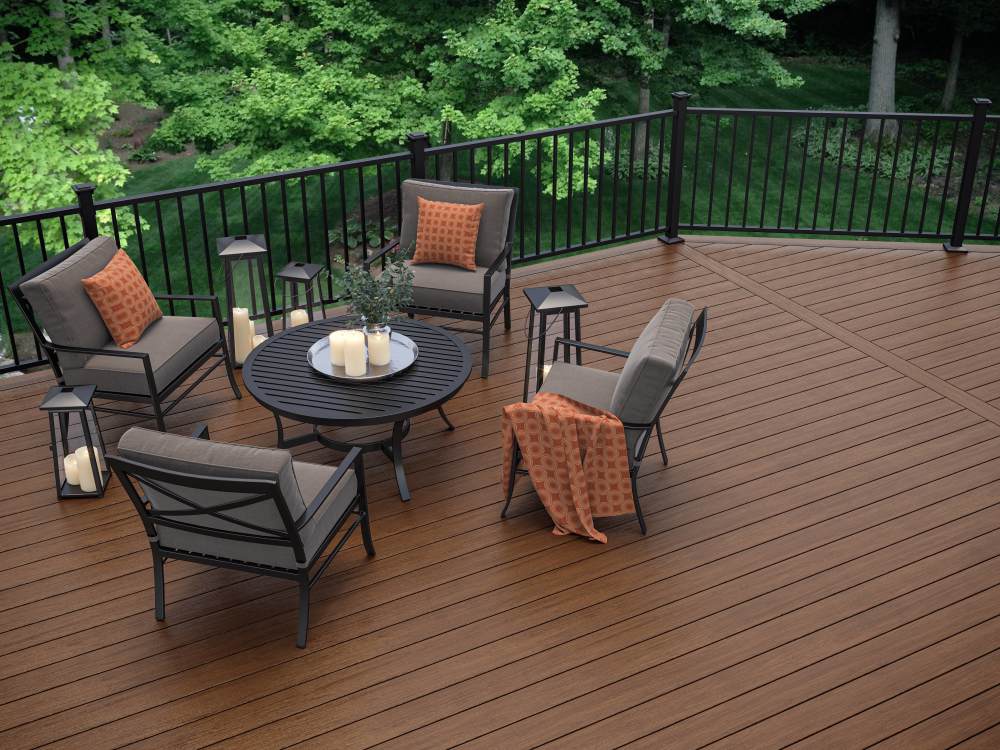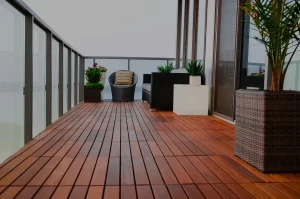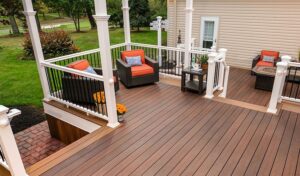Composite deck flooring is not just another outdoor decking option; it’s a versatile and stunning choice that transforms your outdoor space into a haven of beauty and functionality. In this article, we will explore the allure and practicality of composite deck flooring, unveiling the reasons why it has become the top choice for homeowners looking to enhance their outdoor areas.
As we embark on this journey, you will discover what composite deck flooring is composed of, how it’s made, and why it outshines traditional wood decking in numerous ways. We will delve into the world of design possibilities, installation tips, and even cost considerations. Moreover, we’ll touch on the eco-friendly aspects of composite materials, making it not only a wise choice for your outdoor retreat but also a responsible one for the environment.
So, whether you’re envisioning a cozy corner for family gatherings, a serene space for morning yoga, or a vibrant setting for hosting friends, composite deck flooring is your canvas, waiting to bring your outdoor dreams to life. Let’s embark on this exploration of composite deck flooring and unlock the secrets to creating an outdoor paradise right at your doorstep.
What is Composite Deck Flooring?
Composite deck flooring is a cutting-edge and versatile decking material that has revolutionized the world of outdoor design and construction. It represents a significant departure from traditional wood decking, offering a blend of innovation, durability, and aesthetic appeal that sets it apart in the world of outdoor flooring.
At its core, composite deck flooring is crafted by combining several distinct materials to create a composite (hence the name). The typical components include:
Base Material (Polyethylene or Polypropylene): The foundation of composite deck flooring is a robust plastic material, usually either polyethylene or polypropylene. This base material forms the structural backbone of the composite, providing stability and resistance to moisture.
Wood Fiber or Wood Flour: To achieve the natural look and feel of wood, composite deck flooring incorporates wood fibers or wood flour into its composition. This component not only contributes to the visual appeal but also adds a touch of authenticity.
Additives: Various additives are included to enhance the composite’s performance. These may include stabilizers to protect against UV damage, color pigments to achieve the desired appearance, and bonding agents to ensure all the elements adhere effectively.
The manufacturing process of composite deck flooring is a fascinating blend of science and engineering. It typically involves mixing these materials, extruding them into the desired shape, cooling and shaping the boards, and, in some cases, applying surface coatings or embossing to achieve specific textures or patterns.
The primary purpose of composite deck flooring is to serve as an outdoor flooring solution that combines the best qualities of various materials, resulting in a product that offers:
Durability: Composite deck flooring is exceptionally durable and resistant to issues such as rot, splintering, and warping, which commonly plague traditional wood decking.
Low Maintenance: Unlike wood, composite deck flooring doesn’t require the rigorous upkeep of regular staining, sealing, or painting. It maintains its appearance with simple cleaning, making it an excellent choice for those seeking hassle-free outdoor flooring.
Aesthetic Appeal: With a wide range of colors, finishes, and textures available, composite deck flooring replicates the beauty of natural wood while offering design flexibility to suit various architectural styles and preferences.
Environmental Responsibility: Many composite deck flooring products incorporate recycled materials, contributing to sustainability and reducing the demand for virgin wood.
In summary, composite deck flooring is a modern marvel in the world of outdoor design and construction. It combines the best qualities of different materials to offer a durable, low-maintenance, and visually appealing solution for creating stunning outdoor spaces that stand the test of time. Whether you’re envisioning a serene backyard retreat or a vibrant entertainment area, composite deck flooring is designed to elevate your outdoor experience.
Which is better PVC or composite Deck Flooring?
The choice between PVC (Polyvinyl Chloride) and composite deck flooring largely depends on your specific needs, budget, and preferences. Both materials have their advantages and disadvantages, so it’s essential to consider your priorities when making a decision. Here’s a comparison to help you decide which might be better for your situation:
PVC Decking:
Durability: PVC decking is known for its exceptional durability. It is highly resistant to moisture, rot, insects, and fading. It doesn’t require sealing or staining, making it low-maintenance.
Color Variety: PVC decking offers a wide range of color options, and it retains its color well over time. You can choose from various styles to match your aesthetic preferences.
Easy Maintenance: PVC decking is relatively easy to clean with just soap and water. It’s less prone to staining than some other decking materials.
No Wood Content: PVC decking is entirely synthetic, which means it doesn’t contain any wood fibers. This makes it less susceptible to problems like splintering or decay.
Composite Deck Flooring:
Natural Look: Composite deck Flooring is designed to mimic the appearance of real wood. It can provide a more authentic wood look and feel if that’s what you desire.
Eco-Friendly Options: Some composite deck Flooring products are made from recycled materials, making them a more environmentally friendly choice.
Resistant to Rot and Insects: While not as resistant as PVC, composite deck Flooring is still more durable than traditional wood decking. It can resist rot and insect damage to a certain extent.
Moderate Maintenance: Composite deck Flooring requires periodic cleaning and may need staining or sealing, depending on the specific product and brand.
Considerations for Your Decision:
Budget: PVC decking tends to be more expensive upfront than composite deck Flooring. However, its low maintenance costs can make it cost-effective in the long run.
Climate: If you live in a region with harsh weather conditions, such as extreme heat or cold, PVC decking’s durability may be an advantage.
Aesthetic Preferences: If you prefer a more natural wood appearance, composite deck flooring might be a better fit. PVC decking offers more color choices and a consistent appearance.
Environmental Concerns: If eco-friendliness is a priority, some composite decking options made from recycled materials may align better with your values.
Maintenance Commitment: Consider how much time and effort you’re willing to invest in maintenance. PVC decking typically requires less maintenance than composite.
Ultimately, both PVC and composite deck flooring have their merits, and the “better” option depends on your specific circumstances and preferences. It’s essential to research different brands and products within each category to find one that suits your needs and budget best. Additionally,
consulting with a professional and seeking local recommendations can be beneficial in making an informed decision.
Is Composite Deck Flooring strong?
Yes, composite deck flooring is generally strong and durable. Composite deck flooring boards are engineered to be robust and capable of withstanding the elements and regular use. The strength of composite deck flooring comes from its construction, which typically consists of a blend of wood fibers or wood-plastic composite (WPC) and a synthetic material, such as polyethylene or polypropylene.
Here are some factors that contribute to the strength of composite deck flooring:
Material Composition: Composite deck flooring combines wood fibers or wood particles with plastic or resin binders. This blend creates a material that is more resistant to moisture, rot, and insects compared to natural wood, making it strong and durable.
Design and Engineering: Composite deck flooring boards are designed and manufactured to be structurally sound. They often include features like reinforced cores, grooves for improved stability, and hidden fastening systems to enhance their strength.
Durability: Composite deck flooring is designed to withstand the elements, including UV rays, moisture, and temperature fluctuations. This durability contributes to its long-term strength and performance.
Low Maintenance: The low-maintenance nature of composite deck flooring means that it won’t weaken or degrade as quickly as natural wood, which requires regular staining, sealing, and maintenance to maintain its strength.
Resistant to Warping and Splintering: Composite deck flooring is less prone to warping, splintering, or cracking compared to traditional wood decking, further enhancing its strength and safety.
Manufacturer Specifications: The strength of composite deck flooring can vary depending on the brand and product. Manufacturers typically provide specifications related to load-bearing capacity, span, and other structural considerations. It’s important to follow the manufacturer’s guidelines for installation and usage to ensure the decking remains strong.
While composite decking is strong, it’s crucial to select a reputable brand and product that meets your specific requirements. Different composite deck flooring products may have varying levels of strength, so it’s a good idea to consult the manufacturer’s information and potentially work with a professional to ensure proper installation and performance.
conclusion
In conclusion, composite deck flooring stands out as a highly practical and resilient choice for outdoor spaces. Its strength, durability, and resistance to moisture, insects, and rot make it a dependable alternative to traditional wood decking. Composite decking’s versatility shines through its diverse range of colors and textures, enabling homeowners to achieve their desired aesthetic while benefiting from low-maintenance requirements.
While the initial cost of composite deck flooring may be higher than that of wood, its long-term value becomes evident through reduced upkeep expenses and an extended lifespan. Moreover, some composite deck flooring options are eco-friendly, composed of recycled materials, aligning with sustainability objectives.
Selecting a reputable brand, adhering to installation guidelines, and factoring in individual preferences and needs are essential to maximizing the advantages of composite deck flooring. With proper care, composite deck flooring offers a robust, visually appealing, and hassle-free solution for creating enduring outdoor spaces, making it a compelling choice for homeowners seeking both form and function in their decking materials.





